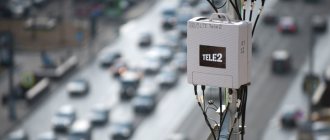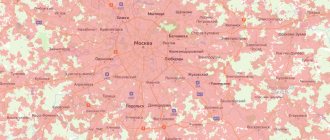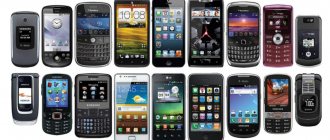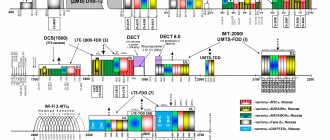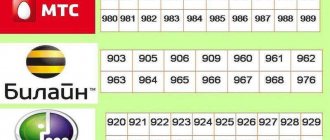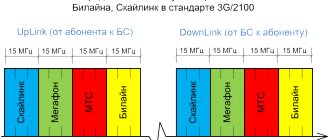A lack of understanding of how communications work, what cellular networks are, how they work, leads to the fact that all problems communication quality often attributed to the operator. While the reason for poor communication may be in the mobile device itself (terminal) or circumstances (more details - how to improve the quality of communication). In order to understand all the nuances and, if possible, not encounter communication problems, we will carry out a small mobile educational program
How is cellular communication organized?
The cellular network is divided into territorial cells (cells). Each cell occupies its own area of territory, which is covered (served) by the base station. The shape and size of the cells depend on many factors, including the radiated power of the base station, standard, operating frequencies, antenna orientation, etc. To prevent a mobile device from losing connection when moving from one cell to another, the cells must overlap each other.
Base stations connected via fiber optic cable communicate between the terminal (telephone) and the base station, after which the conversation or data traffic from the base station is delivered to the switch.
Of course, a uniform distribution of base stations is impossible in urban areas due to architectural obstacles. Therefore, all operators are trying to reserve additional capacity in large cities and create overlapping zones for base stations. To close the so-called “holes” in network coverage, cellular operators install their base stations both in office buildings, industrial premises and stores, and on the roofs of residential buildings. This makes it possible to more evenly cover an area and allow mobile devices to reliably register with the network.
To serve thousands of users, operators buy frequency bands for a lot of money - this is a limited and extremely valuable resource, for the licensing of which the government pays a lot of money. And not just money. For example, in Russia, the Ministry of Communications stipulates in the license the operator’s obligations to provide communications not only to cities that are profitable for cell phones, but also to sparsely populated areas where building base stations is obviously an unprofitable business. Therefore, the cost of installing base stations and building networks in small cities is offset by services in large ones.
We offer proven equipment to enhance communication quality - professional assistance in choosing and installing a GSM signal amplifier
Consultation with a specialist: Tel.,
What is a “Communication Quality Map”?
Communication Quality Map
“Communication Quality Map” is a people’s project launched by the Russian Ministry of Telecom and Mass Communications. The purpose of this service is to summarize information about the quality of mobile communications in certain areas of our vast homeland. The source of information about the quality of mobile communications is not the reports and reports of operators, but the citizens themselves who have downloaded the corresponding application.
Related links: State assistance and benefits for large families in 2021
This application records the quality of communication on a mobile device in real time every 5 minutes and transmits the information to a single database once every 4 hours. Based on this information, a national “Communication Quality Map” is formed online. Anyone can look at the map from a personal computer or gadget, which is available at the link – https://geo.minsvyaz.ru. Unfortunately, the application is currently only available for mobile devices running the Android operating system. You can download this application on our website.
Russian communication standards
Various communication standards are necessary to maintain the functionality of all mobile terminals (various models of mobile devices).
Basic standards:
- GSM standard - operates in the 900 and 1800 MHz bands. The GSM 900 standard is good for covering large areas and “punching” the walls of buildings,
- GSM 1800 - for servicing a large number of subscribers. The range of GSM 1800 base stations is much shorter, but the capacity is greater.
- UMTS (3G) networks operate in the 900 and 2100 MHz bands
- The 800 MHz band is well suited for “forests and swamps”
- The 2600 MHz band provides the necessary network capacity in cities
- LTE (4G) of two varieties (FDD and TDD) operates in several frequency bands CDMA (Skylink) in the 450 MHz range. This standard (LTE Advanced (LTE -A) with frequency aggregation) allows you to combine and share multiple frequency bands in different ranges and achieve fantastic data transfer speeds.
- 5 G -
5 G
telecommunications standard should provide higher throughput compared to 4G technologies, which will ensure greater availability of broadband mobile communications. For the full functioning of 5 G mobile communications networks,
it is necessary
to deploy networks in freer high-frequency bands.
Best Mobile Operators 2021
The number of television systems is growing every year. However, in the ranking of the best mobile operators in Russia, the following companies invariably lead:
- MTS;
- Megaphone;
- Beeline;
- Tele 2.
All companies included in the top have both their positive sides and disadvantages. It must be said that by monitoring cellular phones, the opinions of subscribers are taken into account first of all when evaluating television systems.
One cannot fail to mention the Yota company, which has recently proven itself to be the best. However, this television system cannot participate in a full assessment, since it is only a branch of the MegaFon television system.
When compiling a rating of mobile operators, many factors are inspected. The most important ones include:
- quality of mobile communications;
- mobile Internet speed;
- volume of SMS delivered;
- tariffing of services;
- the amount of network coverage.
Coverage area
Research in this area only covers LTE (4G) coverage. This happens due to the fact that many cellular providers lease towers from other television systems, and it is difficult to find out the level of standard coverage.
We will consider this indicator using the example of Moscow and the region, because it is in this corner of the country that the largest number of towers are concentrated. So, the places according to the density of cellular coverage were distributed as follows (data are given as percentages):
- MegaFon – 32.4%;
- MTS – 31%;
- Beeline - 28.8%.
The Tele2 television system, unfortunately, was not included in the top, as it cannot boast of a large coverage area.
Price
As you know, price plays an important role for a subscriber when choosing a particular mobile operator. According to independent analysts from ComNews Research, on average, Russian subscribers have to pay 350 rubles for a minimum set of cellular services. per month.
But here, too, not everything is so simple. For example, for communication within the region, the MTS operator became the cheapest. And if we talk about accessible communication throughout Russia, Tele2 is the leader here.
However, when assessing the availability of communications, average tariffs are taken into account, with approximately the same packages of cellular services. So, the places in the “Cost” cell were distributed as follows:
- Tele2;
- Beeline;
- Megaphone;
- MTS.
As you know, any television system has its own characteristics. For example, some company is focused on cheap mobile Internet, and some on affordable voice communications. It is for this reason that many clients use several SIM cards at once.
Internet quality
If we talk about the quality of the Internet, then the difference between television systems is more significant. The undisputed leader in high Internet speed is MegaFon. However, this mobile operator, unfortunately, has a large number of failures when connecting to IP/TCP and http. In the first case, the percentage of failures can reach up to 3, in the second up to 4.4%. The lowest percentage of network failures was recorded for the MTS television system, only 0.6 and 0.8%.
But despite this, as of 2021, the leaderboard looks like this:
- MegaFon – starts the report at 14 Mbit/s;
- MTS – from 10.1 Mbit/s;
- Tele2 – from 9.4 Mbit/s;
- Beeline - from 5 Mbit/s.
Connection quality
In terms of voice quality, Megafon also turned out to be the best. When compiling this rating, the main criterion was the total number of network failures. According to experts, the places here were distributed as follows:
- MegaFon – 0.7% network failures;
- MTS – 0.9% of failures;
- Tele2 – 1.2%.
Beeline, unfortunately, was not included in the leaderboard, as it has as much as 15.1% (!) of network failures.
Frequency Coverage Efficiency
The lower the frequency, the better the signal penetration through the walls of buildings and the greater the “range” of base stations and terminals. Skylink has the lowest frequency in Russia (450 MHz), thanks to which a small number of base stations can “cover” vast territories. The Skylink signal is often present in the wilderness, where none of the other operators have yet reached. But the Skylink standard (CDMA 450) supports a small number of Chinese phones and smartphones.
As the prevalence of terminals supporting 3G and 4G grows, operators begin to “take away” some bands from their GSM networks and launch LTE (4G) on these bands. Nowadays, the 1800 MHz band is increasingly used for LTE. In the foreseeable future, it is possible that LTE will move to the 450 MHz band and support for this range will appear in most modern smartphones. This is an opportunity to serve many more subscribers. However, there are relatively few operators working in 4G LTE TDD.
To provide the necessary capacity in densely built areas with large crowds of people, it is effective to install high-frequency stations of 2100 MHz. The 3G 2100 MHz band “breaks through” thick walls and serves those who find themselves between the coverage areas of base stations. Reception power in this range can be provided using the VEGATEL VT2-3G-kit
COMPATIBILITY OF TERMINALS, SELECTION OF A MOBILE DEVICE WITH GOOD CONNECTION
Whenever possible, manufacturers of smartphones, tablets and other electronics adapt their devices to specific markets. Such devices usually have access points registered, work with multiple SIM cards from different operators has been tested, and the correct settings for the network have been set in the phone’s engineering menu. The same model can be configured so that its local version will work better on the network than an analogue imported from Europe or the USA. The question is the settings that were made for Russia, and how universal or specific they are. This also directly affects the operating time of your device and the speed of registration on the network. For example, when buying the latest smartphone, not intended for Russia, that supports 4G frequency aggregation, you may encounter the fact that speeds are not supported in Russian conditions.
Often phones claim to support a full set of standards, the usual description looks like this - GSM 850/900/1800/1900, 3G 900/2100, 4G LTE FDD, and then there is a list of ranges or, as they are also called, bands. For example, if the MegaFon network supports LTE Advanced, then your smartphone or tablet must also support this technology and these frequencies, otherwise do not expect greater speed and quality of communication.
For LTE in Russia, the band 20 standard is used , while many Asian models do not have it. For example, iPhones imported from China can operate in band 7 (2600 MHz), but do not support LTE 800 MHz (Band 20). In addition, it is worth considering that our operators have relatively few frequencies in Band 20, and networks in this range are not being developed so actively. Owners of such iPhones should not complain about low speed and “bad operator”. With LTE in the 1800 MHz band, not everything is smooth either: your favorite LTE router in the 1800 band may not work, and again the “bad operator” will be to blame.
Typically, most devices sold in Russia fully support local frequencies, but “gray” devices may be intended for other markets, so you should carefully read the support of the used bands of the terminal and operator.
What do market participants think about the initiative?
According to MegaFon representative Dmitry Lukyanchikov, the mobile communications market is one of the highly competitive in Russia and in the case of poor-quality services. “In this regard, any such initiatives should be considered and assessed from the point of view of the simplicity and understandability of the proposed procedures and rules for the end subscriber, which in this case is not yet possible to assess,” he said. Anna Aibasheva, spokeswoman for VimpelCom (Beeline brand), also believes that “the high level of competition in Russia is the best motivation for operators to maintain quality of service.” MTS declined to comment. A representative of T2 RTK Holding (Tele2) did not answer RBC’s questions.
According to one of the market participants, the results of Roskomnadzor communications quality reviews very often raise doubts. RBC's interlocutor also drew attention to the fact that the law “On Technical Regulation” limits the range of services that can be regulated; for example, the quality of utility services is also not currently regulated, although cases of disconnection of electricity, heat or water supply are not isolated. “Does this mean that residents have the right not to pay for utilities?” — RBC’s interlocutor wondered.
Managing partner Alexander Pakhomov confirmed that the quality of cellular services is indeed not subject to the law on technical regulation, and operators set tariffs for their services independently.
Factors influencing the quality of communication
Many have encountered the fact that during “peak” hours the connection deteriorates greatly or disappears altogether. The fact is that with an increase in load (the number of simultaneously talking), the coverage area of a 3G base station can decrease, up to the appearance of “holes” in the coverage where neighboring cells overlap each other little (closer to the cell boundaries). This is especially noticeable in sparsely populated areas, where extending optical fiber over tens of kilometers is expensive and unreliable. And with the advent of summer residents, mobile Internet is becoming a luxury.
To avoid problems with communication at the dacha, in rural areas you can install cellular amplifiers specifically designed for settlements remote from the city (cellular amplifiers for rural areas).
Weather conditions also affect communications. When it rains, radio relay communication channels sharply lose their capacity. Especially outside the city.
In the city, problems with communication and the Internet arise in densely built areas, on the first and upper floors, in interior and basement rooms; blind spots appear in “Wells” between tall buildings. The reason for poor communication on the upper floors is that stations are placed frequently, and they “shine” low so as not to interfere with each other’s work at the same frequencies. As a result, the inhabitants of the upper floors may “cling” to a distant BS operating at a low frequency, and for some operators the connection may not work at all.
GSM repeaters designed specifically for urban conditions, which ensure the ability of the signal to penetrate through blind spots and through reinforced concrete floors, can restore communication and improve its quality
In any case, you should contact your operator. It happens that problems arise due to overload of a particular base station, or maybe the radio relay communication channel cannot cope.
What determines the quality of communication?
There are always a lot of questions, and everyone answers them differently. After all, today we can no longer imagine our lives without communication with loved ones, without the Internet, and when we cannot get through by phone or work online, we invent different versions of why this happens. Although many already know what 3G, 4G, LTE-Advanced technologies are, what base stations are, fiber optic lines and data transfer speeds. But sometimes we believe completely implausible things.
Today there are a lot of myths about cellular communications that many people believe, and the latest research proves this. In fact, there are truly objective reasons why communication may deteriorate, and there are assumptions.
Experts decided to help us figure out what is a myth and what is true.
So, there is an opinion that “living near base stations is unsafe . 40% of respondents believe in this myth and like to discuss it on the Internet, on various portals. In fact, for the construction and installation of a base station, the operator needs to receive a fairly voluminous package of documents, and security requirements are monitored at every stage, moreover, by various structures and departments. Many studies by telecom industry experts, doctors, and regulatory authorities confirm that base stations are safe for residents. By the way, the further the smartphone is from the base station, the higher its own radiation level.
Myth two: communication deteriorates during a thunderstorm. According to 30% of respondents, when there is lightning and thunder in the sky, communication is worse. This is only partly true: a thunderstorm can affect the quality of communication if a satellite channel is used. But strong wind or rain sometimes damage base stations, the power cable may become disconnected, and increased absorption of waves by rain can degrade the frequency range. At the same time, if we are talking about heavy snowfalls, cyclones, floods, then the occurrence of emergencies can also lead to accidents. Because there is a disruption in the operation of existing equipment: from time to time something gets covered with snow, somewhere a gust of wind unfurls an antenna, etc. Specialists visit such areas in a timely manner and promptly resolve these emergencies.
By the way, 56% of respondents are convinced that “ the quality of communication will be better in the field than in the forest.” And they are right. Mobile communications are a huge network of invisible threads in the air, and if you visualize it, it will become clear: overgrown forests are a serious obstacle to the radio signal. During the period when trees are covered with leaves, the signal level becomes 10 dB lower. There are no such barriers in the field.
It is very often thought that “in transport, communication deteriorates due to movement.” Half of the respondents believe in this myth, but there is only a grain of truth in it. So, people really are constantly moving: in the morning they go to and from work, during the day they move inside business centers and public places, and towards night they move in residential areas. But the connection deteriorates not because of movement (at least not at such speeds), but because of large crowds of people and high load on the network in such places. By the way, 69% of respondents do not believe that communication problems can occur inside a car with tinted windows. In vain, because the metallized film (light transmission less than 15%) used for dimming screens the signal. The quality of the connection is deteriorating. Accordingly, the stronger the tint, the worse the connection.
As for communications on airplanes, many people believe that “on an airplane, communication works from ground base stations . By the way, 60% of respondents agree with this statement, but in reality everything is different. The plane has its own low-power base station, which receives signals from the satellite and processes calls and SMS. It weighs about 1 kg and resembles a radio, but is quite expensive. By the way, giant buildings sometimes also install their own compact base stations to maintain proper communication quality.
Also, many believe in another myth: “the more “sticks”, the better the connection” (we are talking about the scale on the screen of a mobile phone) . 30% of respondents are confident in this. However, the number of “sticks” only indicates the signal level from the nearest base station, and the quality of the network and the load on it are not taken into account. Thus, near the city Christmas tree on New Year's Eve, you may not be able to call your loved ones, even if the base station is nearby. And everyone has probably encountered this. By the way, the opinion that the higher you raise the phone, the better it “catch” , is shared by half of the respondents. And they are right. At altitude there are fewer barriers to the signal. This is due to the penetration of radio waves through various obstacles: fences, structures, thick concrete walls of houses. The signal, overcoming all these obstacles, loses its power, especially in basements, where there is insulation or iron cladding, metallized films on the windows. And if you go higher, these barriers can be eliminated.
Another question that is beyond doubt among 70% of subscribers is that the quality of communication in the phone depends on the age of the SIM . And indeed it is. A card whose service life is more than two years can be considered old. So, if your SIM card is one of the long-lived ones, then in MegaFon stores you can replace it completely free of charge.
And finally. Many people believe that the quality of communication does not depend in any way on the cost of the phone model. Of course, on a budget device the user will have access to reliable communications and the Internet. At the same time, more modern devices that support new technologies can significantly improve the level of services: on a device with H+ support, 4G access to the Internet will be many times faster, and on phones with HD-Voice the sound will be clearer and more multifaceted. Yes, and the quality of communication will always be worse, regardless of whether a satellite channel or fiber-optic link is used, if “gray” uncertified phones are used. And in this case, it is better to replace the device.
To summarize, we note that the quality of communication depends on objective conditions. The owner of the phone just needs to know the basic rules in order to be constantly in touch. So there is a reason to reflect on some myths and take note of some useful recommendations.
Author: Advertising INFPOL.RU
WHICH COMMUNICATION OPERATOR IS BETTER
Deciding on the best operator based only on the number of base stations it has is wrong.
After all, there are more and more communication standards and they all have their own specifics: 2G for voice, 3G/4G and their intermediate versions for data transmission, as well as voice (3G, and Voice over LTE is also appearing). In theory, the winner is the operator that has a balanced number of both 2G stations, which provide good voice and SMS coverage, and 3G/4G stations. Therefore, any operator at certain points can be either very good or very bad. Marketing terms about 4G, 4G+ today do not guarantee the quality of communication. It is important to understand what speeds are achievable in practice and what the pitfalls are. How well does voice communication work? The presence of low frequencies at the operator's disposal will provide the “penetrating power” of the signal. Formally, it turns out that the more standards your operator supports, the greater the likelihood that you will not be left without communication.
Of course, it is worth considering the number of base stations and the number of modern stations that are united by high-speed optics for those who privately travel around the world. Among the operators we can note Megafon, which is actively and the first to develop stations of new generations and has the maximum frequency resource. The company has approached the theoretical maximum of base stations for all territories in Russia.
General conclusion
The more supported standards your phone has and the more your operator has, the more reliable the connection in most cases, especially for mobile Internet.
Who has better connection quality?
According to measurements carried out by the GRCHTS in Moscow in April-July 2018, among the Big Four operators, MegaFon had the highest proportion of unsuccessful voice calls and calls with low speech intelligibility (2.5 and 1.4%, respectively), the smallest is at T2 RTK Holding (0.5 and 0.1%).
The highest share of undelivered SMS and the longest average delivery time was recorded by T2 RTK Holding - 1.9% and 8.9 seconds. MTS has the best performance in this category - 0.5% and 3.9 seconds.
The best mobile Internet speed was shown by MegaFon (in the direction to the subscriber it was 13,885 Kbps) and MTS (in the direction from the subscriber - 3,035 Kbps, in the direction to the subscriber - 13,113 Kbps).
Various analytical companies periodically publish their research on communication quality. However, market participants criticize such reports, saying that their customers, as a rule, are those operators whose communication quality the authors of the study recognized as the best.
